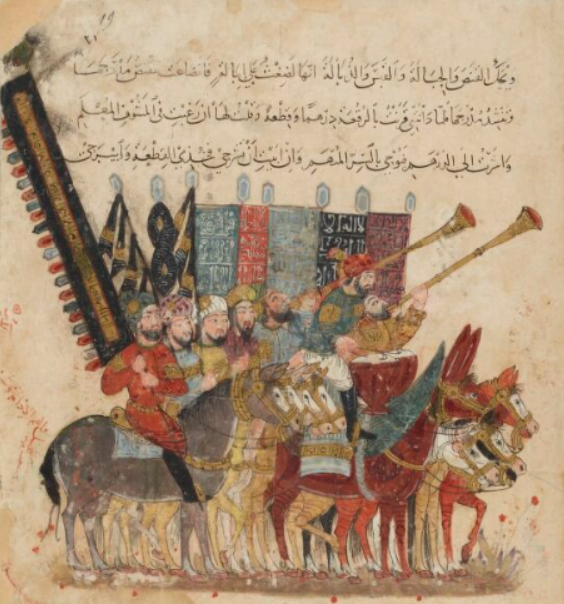To view all courses with instructors, day/time and number of seats available:
View the Timetable Builder to search for courses
In Timetable Builder, select your Faculty & Session.
- In the Faculty/Division field, select Faculty of Arts & Science only.
- In the Session field, select the terms for the courses you are interested in taking. Note: If you select Fall 2023 (F) and Winter 2024 (S), you will not see Fall-Winter 2023-2024 (Y) courses. You have to select all three terms to see F, S and Y courses.
- Under the Search for Courses section, you can search for courses using keyword (e.g., history, Shakespeare, anatomy), course name or course code found in the Academic Calendar, or entering NMC in the Department field.
NMC Newly Offered Courses for Fall/Winter 2023-24
* Click the course title to view the details of the course.
200 level course

This course surveys the premodern Arabic literary heritage, from pre-Islamic poetry to Mamluk literature, focusing on “classics,” meaning texts that have remained influential until the present day. Students read works in translation each week, while discussion focuses on social context and close reading. The class builds close reading skills through class discussion, in-class exercises, and short essays. Readings include: the animal fable book Kalila wa-Dimna, excerpts from anecdote collections, multilingual Andalusi songs (muwashshah), the linguistically playful trickster tales called Maqamat, an obscene shadow play by Ibn Daniyal, popular epic, and some of the most famous poems by Labid, Jarir, Abu Nuwas, Abu Tammam, al-Mutanabbi, and Ibn Nubata.
Winter 2024 - Tuesdays, 11 am -1 pm
The formative period of Islam, including the Prophet and origins of the caliphate. This course surveys the history of the Middle East and its religious, social, and political transformations between late antiquity and the medieval period, from roughly the 6th to the 10th century CE. Starting with the available evidence on pre-Islamic Arabs, we study the making of the Islamic empire from Spain to Central Asia, the early caliphates (Umayyads, Abbasids, and Fatimids), the emergence of competing traditions in Islam (Sunnis, Shi‘is, and Ibadis), and other developments of enduring significance. Particular attention is paid to primary sources and scholarly debates on the challenges of early Islamic historiography.
300 level course
For many people, King David is one of the most beloved characters in the Bible. But where did our ideas about David come from? Was he a brilliant poet who wrote many of the Psalms, a youthful champion who defeated the giant Goliath or as a ruthless monarch capable of killing his political opponents? This course will explore attempts to reconstruct the historical David from various biblical texts, comparable ancient literature, and what historians know (and don’t know) about the time in which his story is set. All readings will be in English. No knowledge of Hebrew is required.
Over the centuries, Samson has captured the imagination of countless scholars, artists, and poets. Although often stereotyped as little more than a thoughtless strong man prone to violent outbursts, he is actually one of the most complex and enigmatic characters in the Bible. This course will explore biblical depictions of this often misunderstood figure and his complicated relationships with his family, his lovers, and his enemies. We will analyze his story within its ancient historical context and in some more recent interpretations. All readings will be in English. No knowledge of Hebrew is required.
The political, religious, and cultural history of greater Iran from Late Antiquity to the Mongol invasions in the early 13th century. The course surveys the reigns of the kings of the Sasanian empire (3rd–7th centuries); traces the progress of the Muslim Arab conquests in the mid-7th century that resulted in the Persian empire’s collapse and the gradual Islamization of its population; and examines the subsequent formation of regional Iranian dynasties that were instrumental in the creation of a new Perso-Islamic cultural identity.
The course focuses on the period of the Safavid dynasty (16th–18th centuries) which represented a watershed in the history of Iran not only because of its adoption and promotion of Shi‘ism as the state religion, but also on account of its fostering an imperial court culture that patronized the arts and architecture. The reigns of the Safavid shahs will be examined from the point of view of their political, religious, economic, and cultural history, as well as their relationship to the polities that immediately preceded them and their interactions with the contemporary Muslim states they neighboured, in particular, the Ottomans in the west and the Mughals in the east.
A comprehensive survey class on the archaeology of Mesopotamia during prehistoric periods (10,000 – 2300 BC), covering the rise of villages, the Agricultural Revolution, the development of cities, cultic centers, and complex bureaucracy, and the rise of state entities during the Neolithic, Chalcolithic and Early Bronze Ages. This class will focus on the area of modern-day Iraq but will also consult materials from western Iran, eastern Syria, and southeastern Turkey.
How did Islam spread in the world? The question has puzzled historians for years. For centuries after the rise of Islam, much of the Middle East was still largely comprised of diverse communities of non-Muslims. This course on the complex history of “Islamization” examines when, how, and why various societies became majority Muslim, through a close look at case studies and sources from across the medieval world including Spain, North Africa, Central Asia and India. Topics covered include religious tolerance, polemic, cultural assimilation, minority identities, interreligious marriages, children of mixed families, and the contentious issues of apostasy and forced conversion.
Pre-requisites: NMC103H1 or NMC273Y1
A survey of the Ottoman Turks from their late 13th–early 14th century origins on the frontiers of the Seljuk, Mongol, and Byzantine empires to their establishment of an Islamic empire. Topics include the principalities known as beyliks that came into being in Anatolia as the above empires declined, the nature of the early Ottoman beylik, conquests in the Balkans, the destruction of the early Ottoman state by Timur and its rebirth, and Mehmed II’s conquest of Constantinople. Coverage includes Ottoman institutions, economy, society, and culture.
A survey of the Ottoman Empire in the 16th and 17th centuries. From the victory by Selim I the Grim over Safavid Iran and conquest of Syria and Egypt to the resplendent age of Süleyman the Magnificent to the internal and external challenges that forced transformation or decline. Topics include wars in Europe, the Mediterranean and Black Seas, and with Iran; internally, the rise of the harem and “sultanate of the women,” rebellions in Anatolia, military reform, religious controversies, and art and architecture. The endpoint is the Treaty of Karlowitz (1699) when the expansion of the empire ended.
400 level course
This course is designed for students who have already completed NML360Y1 Intermediate Persian or have an equivalent level of proficiency in Persian. This course aims to develop students’ abilities at an advanced level, with a focus on complex reading materials including historical, socio-political, media and journalistic texts. Students will improve their reading comprehension, strengthen writing skills, and advance speaking and listening skills through class discussions and oral presentations.
NMC Topic Courses for Fall/Winter 2023-24
* Click the course title to view the details of the course.
Topics in Near & Middle Eastern Civilizations
This course takes a comprehensive look at the history of modern Turkish literature from 1923 onwards, focusing on a variety of genres, with special attention to short stories, poetry, and novels, all of which will be examined through their English translations. The course highlights influential figures and central themes in Turkish literature, exploring how these literary works represent Turkey's social, cultural and political transformations. The course will also consider the growing presence of Turkish literature within the global Anglophone literary marketplace and will address key issues such as the process of selecting authors for translation and the decision-making authorities involved. By the end of the course, students will have gained a deep understanding of Turkish literature and developed critical reading skills that will enable them to analyze literary texts effectively.
MONEY is a way to:
● exercise power,
● affirm relationships,
● demonstrate values & commitments.
Explore medieval women’s social roles, advantages, vulnerabilities, choices, fears, and desires by examining how they gained and spent their money.
Consider the experiences of diverse women
● royal and enslaved;
● Muslim, Christian, and Jewish;
● conservative and rebellious;
● who worked within the home, and who worked outside of it.
Our sources will include religious texts, legal treatises, biographies, humorous tales, lawsuits, personal letters, and more.
Advanced Topics in Near & Middle Eastern Civilizations
The course description will be updated.
Digital technology and “big data” are transforming not only the ways in which archaeologists present and communicate their research, but also increasingly the ways they collect and analyze data. Modern archaeology is also becoming progressively more multi-disciplinary, and reliant on the analysis of growing bodies of disparate forms of data, both archaeological data, and data from related fields. This course exposes students to the underlying concepts of the emerging field of data science and helps them develop hands-on skills in various critical techniques in archaeological data analysis. Where possible, this course will focus on case studies from the Near Eastern world. No previous background in data science or programming is required.
The pandemic of the 1340-50s, known as "The Black Death," was only the peak of a much longer experience of a plague caused by the bacterium Yersinia pestis. The plague reached the Abbasid Empire in the 13th century and may have contributed to its fall, and devastating plague outbreaks continued well into the Ottoman Era. In this course we will examine how globalization, climate change, war, and religion impacted how people experienced the plague. We will explore how the plague impacted social life, religious beliefs and mental health, travel, economic and demographic developments, and politics and international diplomacy. We will also learn how historians and scientists in the past three years have made, and continue to make, radical breakthroughs which have completely reshaped our understanding of what happened in the past. All readings will be provided in English.


